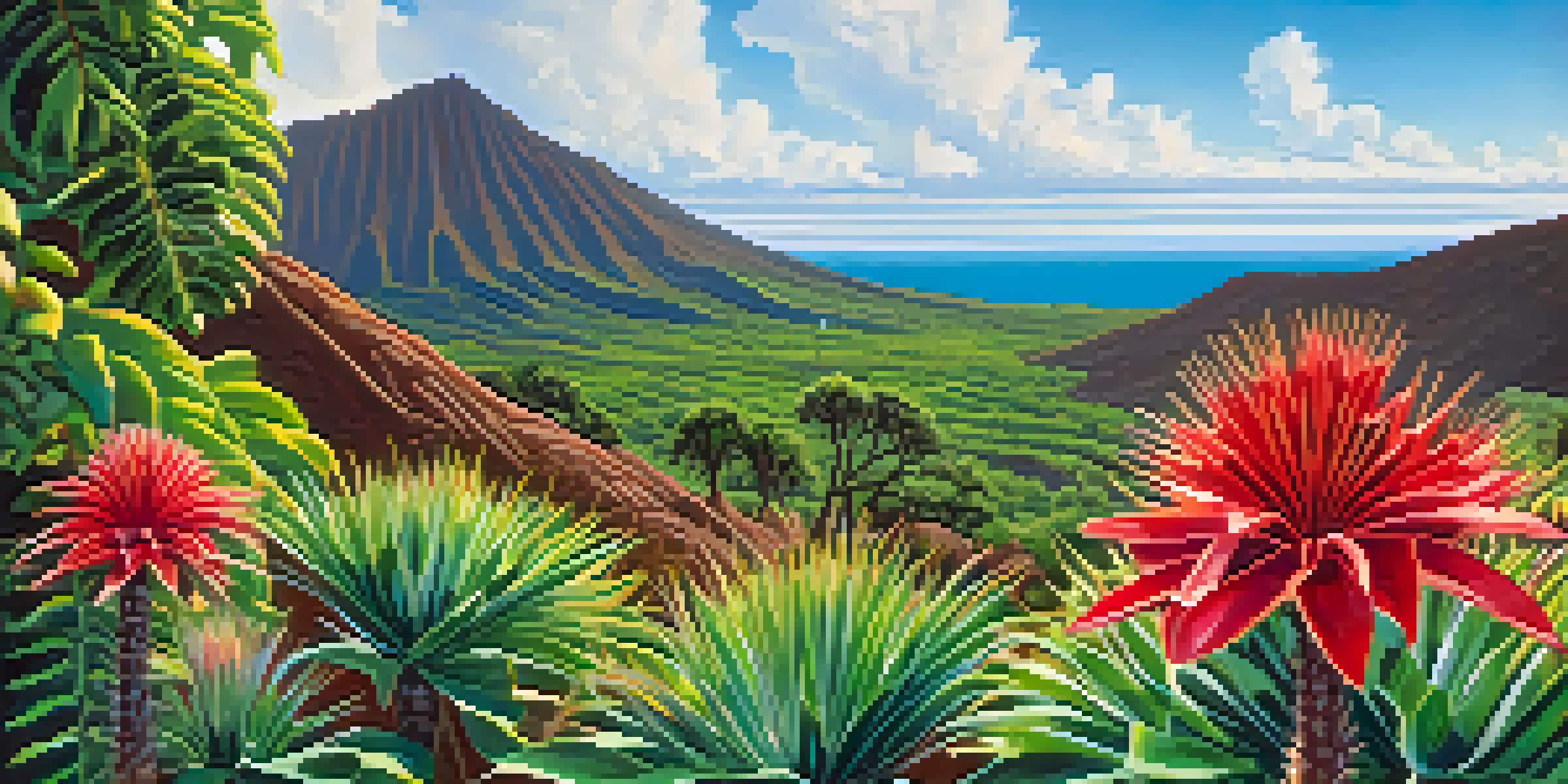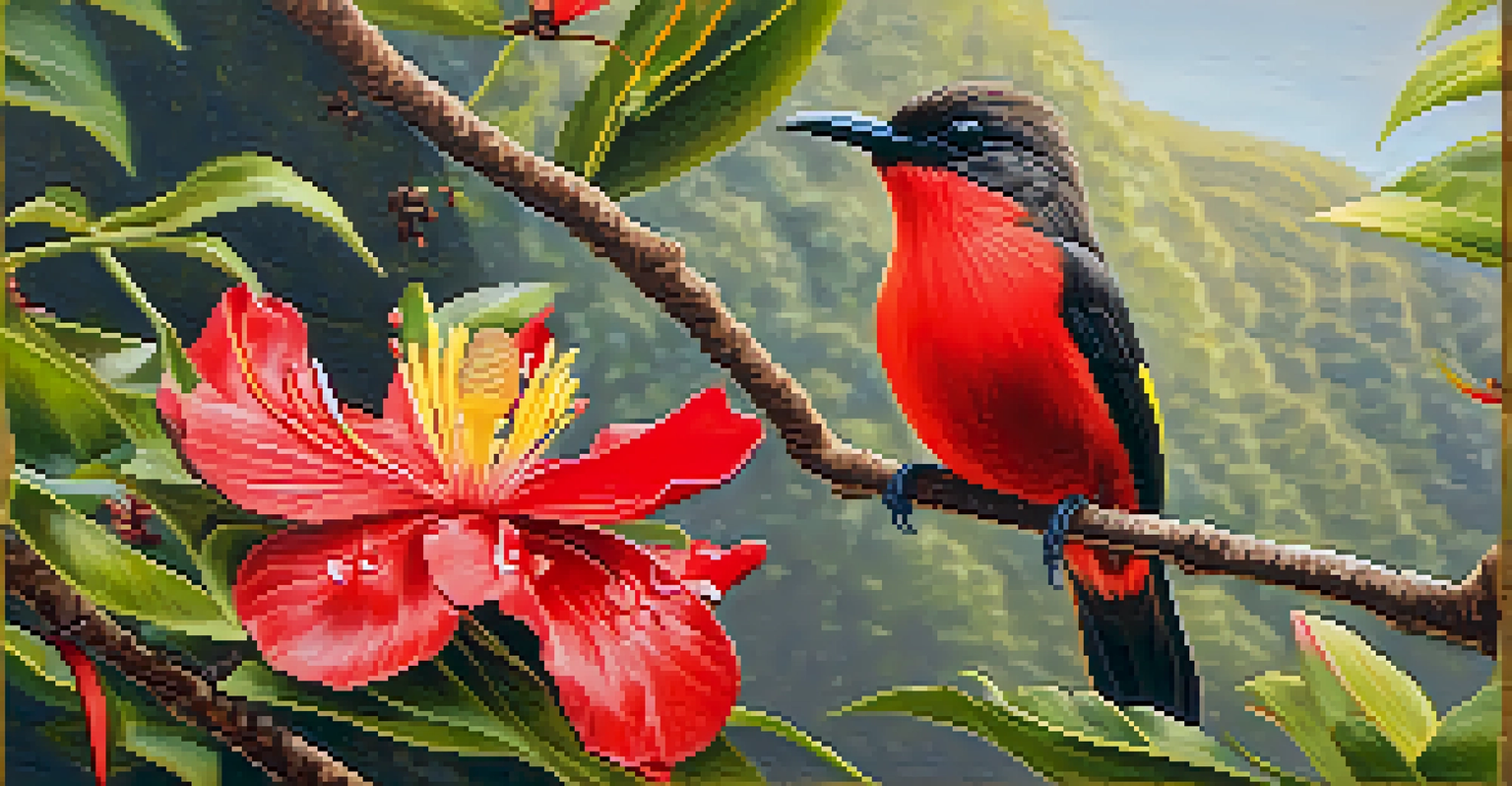Hawaiian Ecosystems: Interactions Between Flora and Fauna

Introduction to Hawaiian Ecosystems and Biodiversity
Hawaii's ecosystems boast a rich tapestry of biodiversity, making it a unique hub for various plant and animal life. With its isolation in the Pacific Ocean, the islands have cultivated a range of species that are found nowhere else on Earth. This unique environment has led to intricate relationships between flora and fauna, where each organism plays a vital role in the ecosystem’s health.
The preservation of our environment is not a task for the future but a necessity for today.
For instance, the native silversword plant has adapted to the harsh volcanic soils of Hawaii, while providing shelter and food for numerous insect species. These interactions highlight the delicate balance within these ecosystems, where even the smallest creatures contribute to the overall health of their habitat. Understanding these relationships is essential for conservation efforts.
In this article, we will delve into the fascinating interactions between Hawaiian flora and fauna, exploring how they coexist and support each other in this breathtaking environment.
The Role of Native Plants in Hawaiian Ecosystems
Native plants are the backbone of Hawaiian ecosystems, providing food and shelter for various animals. Species like the Hawaiian hibiscus and the koa tree not only contribute to the aesthetic beauty of the islands but also play crucial roles in sustaining local wildlife. These plants have evolved alongside native animals, creating a symbiotic relationship that enhances biodiversity.

One example is the way the ʻōhiʻa lehua tree supports the Hawaiian honeycreeper, a bird that relies on its nectar for survival. As the honeycreeper feeds, it inadvertently helps pollinate the tree, ensuring the continuation of both species. This interconnectedness illustrates how native plants and animals depend on one another, forming a complex web of life.
Biodiversity's Unique Interconnections
Hawaii's ecosystems showcase intricate relationships between native plants and animals, highlighting their mutual reliance and the importance of preserving these connections.
Moreover, preserving these native plants is essential for maintaining the health of the entire ecosystem, as they provide the foundational support for other forms of life.
Animal Adaptations to Island Life in Hawaii
The animals of Hawaii have adapted remarkably to the island's unique conditions, showcasing nature's ingenuity. Birds, insects, and other fauna have developed specialized traits to thrive in their specific habitats. For instance, the Hawaiian goose, or nene, has evolved to become a proficient forager, utilizing the diverse plant life to find food.
In nature’s economy, the cost of one species is the extinction of another; this is the law of nature.
Insects like the Hawaiian happy-face spider have also adapted, developing unique coloration that helps them blend into their surroundings. This camouflage is essential for hunting and evading predators, illustrating how adaptations can enhance survival in a competitive environment. Each of these adaptations highlights the incredible resilience of life on the islands.
These adaptations not only ensure survival but also contribute to the overall balance of the ecosystem, where every species plays a critical role.
Pollination: A Key Interaction in Hawaiian Flora and Fauna
Pollination is a crucial interaction in Hawaiian ecosystems, linking plants and animals in a mutually beneficial relationship. Many native plants depend on specific pollinators, such as birds and insects, to reproduce. For example, the brightly colored blossoms of native flowers attract the Hawaiian honeycreeper, which transfers pollen from one flower to another, facilitating fertilization.
This relationship showcases a perfect example of co-evolution, where both the plant and pollinator have adapted to each other's needs over time. Without these pollinators, many native plants would struggle to reproduce, leading to a decline in biodiversity. This emphasizes the importance of preserving both flora and fauna in these ecosystems.
Threat of Invasive Species
Invasive species significantly threaten Hawaii's native flora and fauna by outcompeting them for resources, leading to declines in biodiversity.
Moreover, the decline of certain pollinator species could have cascading effects on the entire ecosystem, highlighting the interconnectedness of life in Hawaii.
Predator-Prey Dynamics in Hawaiian Ecosystems
The predator-prey relationships in Hawaiian ecosystems add another layer of complexity to the interactions between flora and fauna. Native birds, like the Hawaiian owl or pueo, play a crucial role in controlling insect populations, while also being prey for larger birds of prey. This dynamic helps maintain balance within the ecosystem, ensuring no single species dominates.
Invasive species, however, can disrupt these relationships, often leading to declines in native populations. For example, the introduction of rats and mongoose has posed significant threats to ground-nesting birds, disrupting their breeding success. Understanding these dynamics is essential for effective conservation strategies.
Ultimately, preserving natural predator-prey relationships is vital for the health of Hawaiian ecosystems, as they help sustain biodiversity and ecological balance.
The Impact of Invasive Species on Hawaiian Ecosystems
Invasive species pose one of the most significant threats to Hawaiian ecosystems, often outcompeting native flora and fauna for resources. Plants like the giant reed and animals such as feral pigs have altered habitats, making it difficult for native species to thrive. This disruption not only impacts individual species but can lead to a decline in overall biodiversity.
For instance, invasive plants can choke out native species, reducing food sources for local wildlife. This has a domino effect, where the decline of one species can lead to the decline of others that depend on it for survival. The battle against invasive species is ongoing, requiring concerted efforts from conservationists and the community alike.
Importance of Conservation Efforts
Community-driven conservation initiatives are essential for restoring native habitats and ensuring the sustainability of Hawaii's unique ecosystems.
Addressing this issue is crucial for the preservation of Hawaii's unique ecosystems, as protecting native species ensures the health and sustainability of the islands' natural heritage.
Conservation Efforts for Hawaiian Ecosystems
Conservation efforts in Hawaii are vital for protecting the unique flora and fauna that define the islands. Organizations and local communities are working tirelessly to restore native habitats, control invasive species, and engage in educational initiatives. These efforts not only benefit the environment but also promote a deeper understanding of the importance of biodiversity.
For example, community-led programs often involve native plant restoration projects that encourage locals to grow and plant native species in their gardens. This grassroots approach fosters a sense of stewardship and connection to the land, ensuring that future generations will recognize the value of preserving Hawaii's ecosystems.

Through these collective efforts, there is hope for the restoration and protection of Hawaii’s natural heritage, allowing the islands’ unique ecosystems to thrive for years to come.